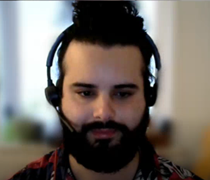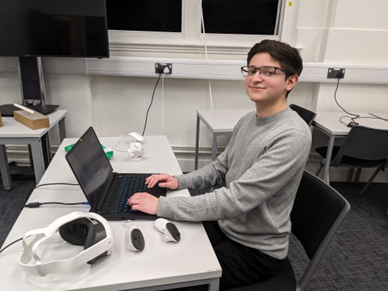Co-creation transforming students to innovate, master new skills, and confidently prepare for the future.


Shane Robert Dunne, a third-year Chemistry student winning the SEDA Student Partnership Impact Award and SEED award, and Enzo Olivieri Cortes, an Astrophysics master’s student, are student partners on a Student Enhanced Engagement and Development (SEED) project at Queen Mary University of London. They work together to create virtual reality (VR) environments for students to practice lab skills, with both Shane and Enzo designing scenarios, building 3D models, and adding AI voice scripts for their respective parts of the project. The Digital Education Studio spoke to them to learn about their experiences and the impact of this collaboration.
At the heart of this initiative is the use of virtual reality (VR) to allow students to practice and perform tasks, like conducting chemistry experiments or practicing medical procedures. VR enables them to interact with virtual objects, simulate real-world scenarios, and build their skills without risking safety or wasting resources. Having Shane and Enzo actively involved ensures the project remains student-focused, innovative, and aligned with real learning needs.
The project thrives on collaboration between students, academics, and an ed-tech partner, Edify. Regular meetings with supervisors Prof. Chie Adachi, Dr Pedro Elston and Prof. Lesley Howell helped maintain momentum, and peer feedback was helpful in shaping the VR scenarios. Enzo emphasized the value of the autonomy and guidance provided by supervisors: “At the start, we had the freedom to choose what aspects of the project we wanted to work on. That autonomy allowed us to focus on developing skills that align with our interests and future careers.”
Shane echoed this sentiment, highlighting the importance of trust and support from academics and peers in the process. “The collaborative environment encouraged creativity and problem-solving,” he said. “We could experiment with ideas, knowing we had the support of our supervisors and peers to refine them.”
Building on a solid foundation of trust and support, Enzo and Shane faced and overcame significant challenges throughout the project. One of the biggest hurdles was managing the limitations of the VR platform. “We came in with ambitious ideas, but we had to adjust to what was feasible within the system,” Shane explained. They tackled this by using creative solutions, such as video overlays, to simulate complex animations that couldn’t be built natively in VR. “This taught us the value of adaptability and working within constraints,” Shane added.
Balancing technical learning with the project’s goals was another significant hurdle. Shane and Enzo learned to use tools like Blender and AI voice-over software, overcoming steep learning curves to create their designs. “At first, learning Blender was challenging, but it became rewarding as we saw our ideas come to life,” Shane shared. Their work includes designing interactive lessons and conducting focus group user testing to refine the scenarios.
Reflecting on the process, Shane said, “Mastering 3D modeling and scriptwriting while ensuring the scenarios were educationally effective was no small feat. It was a steep learning curve, but incredibly rewarding.” By embracing these challenges, they not only developed practical skills but also gained confidence in their ability to problem-solve and innovate.
The project has already yielded significant benefits. Shane and Enzo have gained confidence in technical tools like 3D modeling and AI, while also learning to manage deliverables and expectations when working with industry partners. These skills enhance their employability. The VR headset is currently undergoing user testing and will soon be available for use by the wider student community.
Looking ahead, Shane and Enzo hope this initiative will inspire more student-led co-creation projects. “This project shows what’s possible when students, academics, and industry partners work together,” Shane said. “It’s been an incredible journey, and I’m excited to see how it evolves.”
This co-creation project aligns with Queen Mary’s Strategy 2030, where students actively shape their education and learning environment. It reflects the university's values of teamwork and innovation, combining efforts from students, academics, and industry partners. After hearing about experiences from Shane and Enzo, you might be inspired to try co-creation in your own teaching—visit Queen Mary Academy’s co-creation resources to get started.
